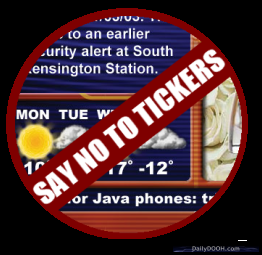News Is Everywhere. Tickers Needn’t Be
Guest Contributor, Dave Haynes, The Preset Group
Stop and think, for a second, what was involved in keeping up on breaking news a decade ago. In July 2000, Clinton was still in the White House, few people had heard of the Taliban or a guy named Osama, the tech fuss was about Napster, and Apple was just trying to stay in business.
 When something big happened in the news, maybe the IT department let you had desktop Internet access at your office. Maybe not. Or you turned on the radio or TV after someone told you to. Here and there, there were these companies putting screens in convenience stores and elevators, and those things had the news on them.
When something big happened in the news, maybe the IT department let you had desktop Internet access at your office. Maybe not. Or you turned on the radio or TV after someone told you to. Here and there, there were these companies putting screens in convenience stores and elevators, and those things had the news on them.
A decade on, news gathering organizations get the first crowd-sourced sniffs at a lot of breaking news by monitoring Twitter, Facebook and blogs, and scouring YouTube. We can get news on our phones, our tablets and our laptops, pretty much no matter where we are. It’s not just CNN and the major broadcasting companies with news programming now. There are multiple all-news, all-the-time resources in many countries.
In short, news is everywhere. It is overwhelmingly ubiquitous. And therefore a near-total commodity.
So why then, as an industry, do we persist in slapping up news headlines on tickers on so many digital signage networks? Do people, standing in line to buy junk food at a corner store or sitting in a food court at a mall, really want to know “Two people die in boat crash in Nebraska” or “Ousted Panama strongman Noriega gets seven years?”
Probably not. But hey, that ticker looks cool!!! Can we do two, and maybe make them go in opposing directions!?!
This is Ticker Free Day – a call to action to get networks de-commissioning at least temporarily the tickers that clutter their screens and distract from the stuff that makes money and engages viewers. I support any and all efforts to rid the industry of the stupid things. They make no sense and actually hurt networks.
But I’ll take this thing a step further.
Are automated, unfiltered, untouched news headlines from companies like Associated Press, Thomson Reuters and other news-gathering (and repurposing) organizations good content for digital signage? Not only just on tickers, but even on effectively presented full-screen Media RSS pieces? In some cases, sure. In many cases, their use defies logic.
Take the time to think about and really understand your viewing audience and both the context and dynamics of the venue and situation. Running news, sports and business headlines is the easy, obvious foundation for content programming. That in no way means it is the best. My friend Denys Lavigne from Arsenal Media talks about the need for networks to earn their audiences. They should not and cannot expect people will watch just because the screen is there. What’s running has to interest them, and the news junkies who do like to stay really current have almost certainly already seen what’s ticking along the bottoms networked digital displays.
Why am I so down on news? Well, I’m not. I was a print journalist for 15 years. This stuff’s in my blood. But just like my beloved newspaper industry is struggling mightily to stay relevant, DOOH networks need to think carefully about ensuring their programming is relevant.

Follow DailyDOOH